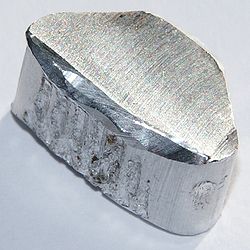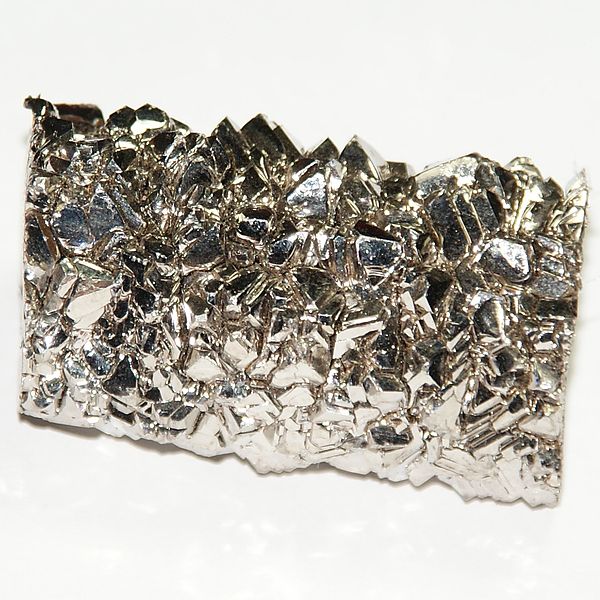Difference Between Aluminum and Titanium
• Categorized under Objects | Difference Between Aluminum and Titanium

Aluminum
Aluminum vs titanium
In the world we live in, there are numerous chemical elements that are responsible for the composition of all the non-living things around us. Most of these elements are natural, that is, they occur naturally whereas the rest are synthetic; that is, they do not occur naturally and are artificially made. The periodic table is a very useful tool when studying elements. It is actually a tabular arrangement that displays all the chemical elements; the organization being on the basis of the atomic number, the electronic configurations and some specific recurring chemical properties. Two of the elements that we have picked up from the periodic table for comparison are aluminium and titanium.
To begin with, aluminium is a chemical element that has the symbol Al and is in the boron group. It has an atomic of 13, that is, it has 13 protons. Aluminium, as many of us know, belongs to the category of metals and has a silvery white appearance. It is soft and ductile. After oxygen and silicon, aluminium is the 3rd most abundant element in the crust of the Earth. It makes up almost 8% (by weight) of the solid surface of the Earth.
On the other hand, titanium is also a chemical element but it is not a typical metal. It belongs to the category of transition metals and has the chemical symbol Ti. It has an atomic number of 22 and has a silver appearance. It is known for its high strength and low density. What characterizes titanium is the fact that it is very resistant to corrosion in chlorine, sea water and aqua regia.

Titanium
Let us compare the two elements on the basis of their physical properties. Aluminium is a malleable metal and is lightweight. Approximately, aluminium has a density that is about one-third that of steel. This means that for the same volume of steel and aluminium, the latter has one-third the mass. This characteristic is very important for a number of applications of aluminium. In fact, this quality of having a low weight is the reason aluminium is used so widely in the making of aircrafts. Its appearance varies from silver to dull grey. Its actual appearance depends on the roughness of the surface. This means that the colour gets closer to silver for a smoother surface. Moreover, it is not magnetic and does not even ignite easily. Aluminium alloys are used widely due to their strengths, which are far greater than the strength of pure aluminium.
Titanium is characterized by its high strength to weight ratio. It is quite ductile in an oxygen free environment and has a low density. Titanium has a very high melting point, which is even greater than 1650 degrees Centigrade or 3000 degrees Fahrenheit. This makes it very useful as a refractory metal. It has fairly low thermal and electrical conductivity and is paramagnetic. Commercial grades of titanium have a tensile strength about 434 MPa but are less dense. Compared to aluminium, titanium is about 60% more dense. However, it has double the strength of aluminium. The two have very different tensile strengths as well.
Summary of differences expressed in points
- Aluminium is a metal whereas titanium is a transition metal
- Aluminium has an atomic number of 13, or 13 protons; Titanium has an atomic number of 22, or 22 protons
- Aluminium has the chemical symbol Al; Titanium has the chemical symbol Ti
- Aluminium is the third most abundant element in the Earth’s crust whereas Titanium is the 9th most abundant element
- Aluminium is not magnetic; Titanium is paramagnetic
- Aluminium is cheaper compared to Titanium
- The characteristic of aluminium that is very important in its uses is its light weight and low density, which is one-third that of steel; the characteristic of titanium that is important in its uses is its high strength and high melting point, above 1650 degrees centigrade
- Titanium has double the strength of aluminium
- Titanium is about 60% denser than aluminium
- Aluminium has a silvery white appearance that varies from silver to dull grey depending on the roughness of the surface (normally more towards silver for smoother surfaces) whereas titanium has a silver appearance
- Difference Between Sunni and Salafi - October 24, 2010
- Difference Between Visa and Work Permit - August 1, 2010
- Difference Between Acrylic and Glass Bongs - August 1, 2010
Sharing is caring!
Search DifferenceBetween.net :
Cite
APA 7
, J. (2014, November 27). Difference Between Aluminum and Titanium. Difference Between Similar Terms and Objects. https://www.differencebetween.net/object/difference-between-aluminum-and-titanium/.
MLA 8
, Jilani. "Difference Between Aluminum and Titanium." Difference Between Similar Terms and Objects, 27 November, 2014, https://www.differencebetween.net/object/difference-between-aluminum-and-titanium/.
8 Comments
Leave a Response
Written by : Jilani. and updated on 2014, November 27
References :
[0]http://commons.wikimedia.org/wiki/File:Aluminium_material.jpg
[1]http://commons.wikimedia.org/wiki/File:Titanium.jpg
See more about : Aluminum, metal, titanium

There are many misspellings and may lead people to think this was written by someone who may not know the most of the properties of titanium vs. aluminum. Please note most of this was plagiarized off Wikipedia.
I know a my engineering professors, a Russian doing research into polymer fluid flow, they all can’t spell. Good points otherwise. I like how It just say twice as strong. Compression, tension, what?
“Aluminum has a recycling quality, whereas titanium has resistance to salt water.” What? It seems like many of the sentences in this article were made by smashing together two completely unrelated facts. Not helpful. Here’s another one: “Aluminum is insoluble in alcohol, and titanium is soluble in concentrated acids.” That seems to imply, falsely, that titanium is soluble in alcohol and aluminum is inert to concentrated acids.
The British have their own way of spelling. To them, aluminum becomes aluminium. Lieutenant becomes Leftenant. Liter becomes litre, meter becomes metre, color becomes colour, humor becomes humour, and so on. How are Americans to judge the people who taught us our language in the first place? Latin became Italian, and so on. but when was the last time you saw an Italian criticize a Latin scholar for his misspellings?. I searched this article and could not find a single instance of ‘recycling quality’ or ‘compression, tension’. What the HECK are you people talking about?
You Yanks are just too stupid.
Always needing to mess up our language
as you would be lost otherwise.
Horse-back riding……….
Sidewalk…………
It’s funny because America is like that big dope
making all the jokes and people just laugh at them.
You lot are the joke…….
I hope you are not referring to our beloved and esteemed President Barack Obama. We the People here in the U.S. laugh at his jokes because he’s witty, funny and has perfect comedic timing. He has taken our minds off our troubles for the last 8 years with his good sense of humor (not “humour”). There have been no scandals under his leadership, and he has kept us out of war. And what’s he have to do with aluminum and titanium?
ROTFL Rick you living in a dream world?
Scandals? too many to count.
Humor? Guess the blindness of people following that fool.
This was quite helpful based upon the info I was looking for concerning which to use for a few ships. #VEGASET #SpaceX